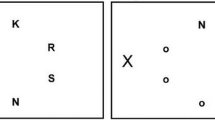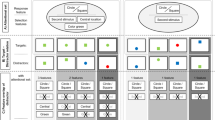Abstract
The relevance of top-down information in the deployment of attention has more and more been emphasized in cognitive psychology. We present recent findings about the dynamic of these processes and also demonstrate that task relevance can be adjusted rapidly by incoming bottom-up information. This adjustment substantially increases performance in a subsequent task. Implications for artificial visual models are discussed.
Preview
Unable to display preview. Download preview PDF.
Similar content being viewed by others
References
Broadbent, D.E.: Perception and Communication. Pergamon, London (1958)
Posner, M.I.: Orienting of attention. The Quarterly Journal of Experimental Psychology 32, 3–25 (1980)
Kahneman, D., Treisman, A., Gibbs, B.J.: The reviewing of object files: Object-specific integration of information. Cognitive Psychology 24, 175–219 (1992)
Simons, D.J., Chabris, C.F.: Gorillas in our midst: sustained inattentional blindness for dynamic events. Perception 28, 1059–1074 (1999)
Folk, C.L., Remington, R.W., Johnston, J.C.: Involuntary covert orienting is contingent on attentional control settings. Journal of Experimental Psychology: Human Perception and Performance 18, 1030–1044 (1992)
Ansorge, U., Kiss, M., Eimer, M.: Goals-driven attentional capture by invisible colours: Evidence from event-related potentials. Psychonomic Bulletin & Review (in press)
Chun, M.M., Potter, M.C.: A two-stage model for multiple target detection in rapid serial visual presentation. Journal of Experimental Psychology: Human Perception and Performance 21, 109–127 (1995)
Ansorge, U., Neumann, O.: Intentions determine the effect of invisible metacontrast-masked primes: Evidence for top-down contingencies in a peripheral cuing task. Journal of Experimental Psychology: Human Perception and Performance 31, 762–777 (2005)
Olivers, C.N., Meeter, M.: A boost and bounce theory of temporal attention. Psychological Review 115, 836–863 (2008)
Van Zoest, W., Donk, M.: Goal-driven modulation as a function of time in saccadic target selection. The Quarterly Journal of Experimental Psychology 61, 1553–1572 (2008)
Raymond, J.E., Shapiro, K.L., Arnell, K.M.: Temporary suppression of visual processing in an rsvp task: an attentional blink? Journal of Experimental Psychology: Human Perception and Performance 18, 849–860 (1992)
Olivers, C.N.L., Watson, D.G.: Input control processes in rapid serial visual presentation: Target selection and distractor inhibition. Journal of Experimental Psychology: Human Perception and Performance 32, 1083–1092 (2006)
Nieuwenstein, M.R.: Top-down controlled, delayed selection in the attentional blink. Journal of Experimental Psychology: Human Perception and Performance 32, 973–985 (2006)
Itti, L., Koch, C.: Computational modelling of visual attention. Nature Reviews Neuroscience 2, 194–203 (2001)
Aziz, M.Z., Mertsching, B.: Fast and robust generation of feature maps for region-based visual attention. IEEE Transactions on Image Processing 17, 633–644 (2008)
Treisman, A.M., Gelade, G.: A feature-integration theory of attention. Cognitive Psychology 12, 97–136 (1980)
Navalpakkam, V., Itti, L.: Top-down attention selection is fine-grained. Journal of Vision 6, 1180–1193 (2006)
Scharlau, I., Ansorge, U.: Direct parameter specification of an attention shift: evidence from perceptual latency priming. Vision Research 43, 1351–1363 (2003)
Bröckelmann, A.K., Junghöfer, M., Scharlau, I., Hamker, F.H.: Reentrant processing from attentional task sets: Converging support from magnetoencephalography and computational modeling (in prep.)
Brainard, D.H.: The psychophysics toolbox. Spatial Vision 10, 433–436 (1997)
Hamker, F.: A computational model of visual stability and change detection during eye movements in real-world scenes. Visual Cognition, 1161–1176 (2005)
Hamker, F.H.: Modeling feature-based attention as an active top-down inference process. Bio Systems 86, 91–99 (2006)
Hamker, F.H.: A dynamic model of how feature cues guide spatial attention. Vision Research 44, 501–521 (2004)
Author information
Authors and Affiliations
Editor information
Editors and Affiliations
Rights and permissions
Copyright information
© 2009 Springer-Verlag Berlin Heidelberg
About this paper
Cite this paper
Hilkenmeier, F., Tünnermann, J., Scharlau, I. (2009). Early Top-Down Influences in Control of Attention: Evidence from the Attentional Blink. In: Mertsching, B., Hund, M., Aziz, Z. (eds) KI 2009: Advances in Artificial Intelligence. KI 2009. Lecture Notes in Computer Science(), vol 5803. Springer, Berlin, Heidelberg. https://doi.org/10.1007/978-3-642-04617-9_85
Download citation
DOI: https://doi.org/10.1007/978-3-642-04617-9_85
Publisher Name: Springer, Berlin, Heidelberg
Print ISBN: 978-3-642-04616-2
Online ISBN: 978-3-642-04617-9
eBook Packages: Computer ScienceComputer Science (R0)




